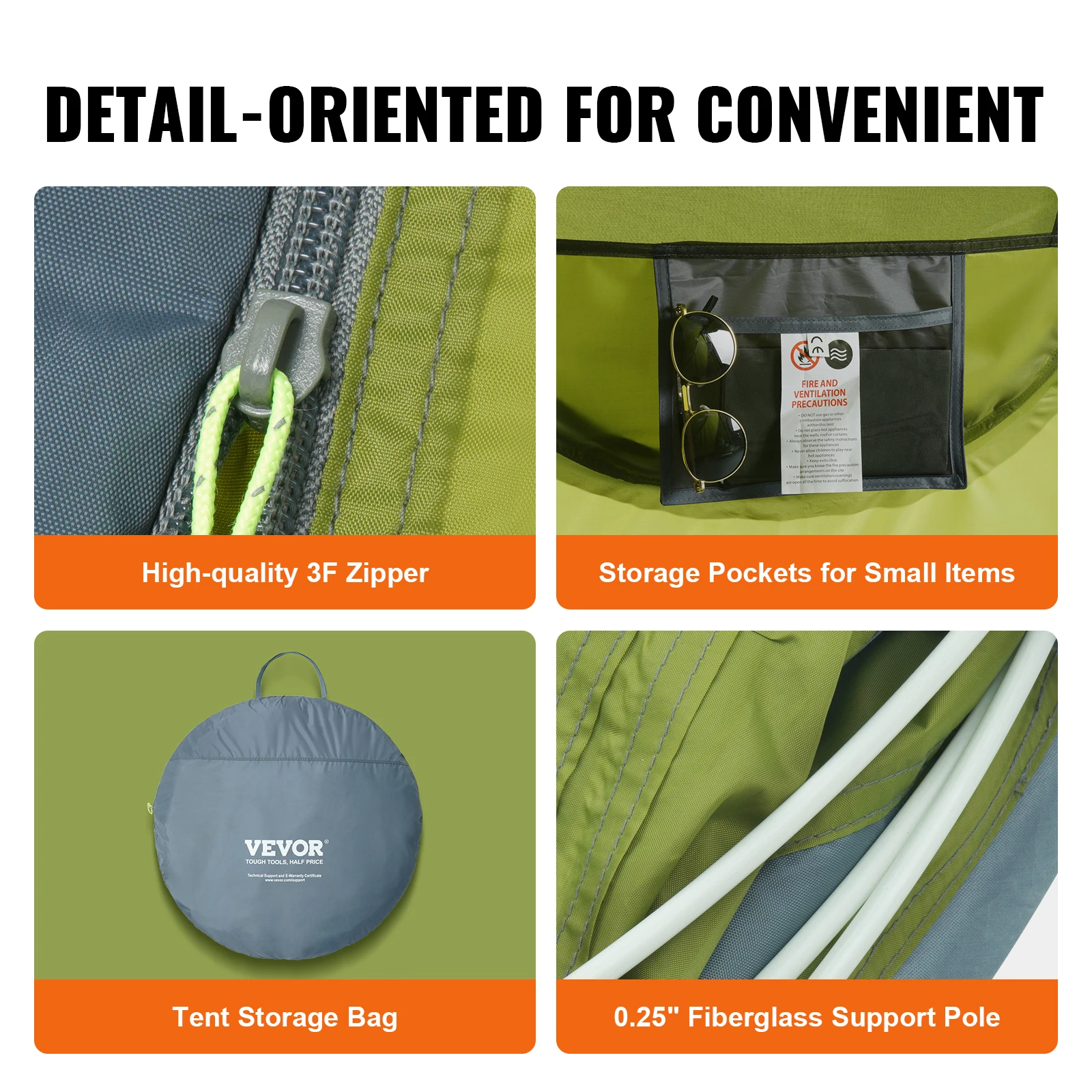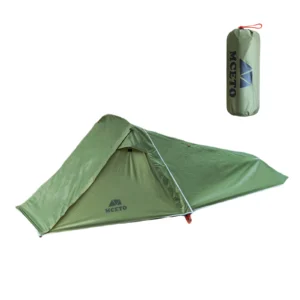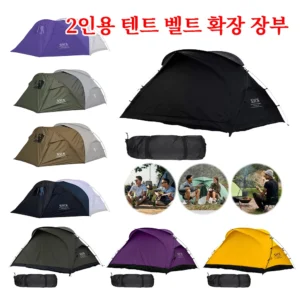Understanding Condensation in Snow Camping
Winter camping brings unique challenges, and one of the most frustrating is waking up to a tent interior dripping with moisture. This isn’t magic or a leak—it’s condensation, and it follows simple physics. When warm, moist air meets a cold surface (like your tent wall), the moisture in the air changes from gas to liquid. This happens at what scientists call the “dew point,” the temperature at which air becomes saturated and can’t hold any more moisture.
In the enclosed space of a winter tent, the contrast between your warm body and breath against the freezing exterior creates perfect conditions for condensation. The temperature difference can be dramatic—while your tent might maintain 50°F (10°C) inside, the outside could be 10°F (-12°C) or colder, forcing moisture out of the air when it contacts the cold fabric.
The main sources of moisture in your tent include:
- Human respiration and perspiration: Each camper releases about 1-2 pints (0.5-1 liter) of moisture overnight just by breathing and sweating
- Wet gear: Snow-covered boots, damp gloves, and wet clothing release moisture as they warm up
- Cooking activities: Boiling water for meals or drinks creates significant steam
- Snow brought in on gear: This melts and evaporates, adding humidity to the tent air
Understanding where this moisture comes from is the first step in creating effective shelter options for two campers that stay dry and comfortable, even in winter conditions.
Why Winter Condensation is Uniquely Challenging
Extreme Temperature Differentials
Winter camping creates condensation challenges far beyond those of summer or fall camping. The temperature difference between your body (98.6°F/37°C) and tent walls in sub-freezing conditions can exceed 60°F (33°C), creating an almost immediate condensation effect as your warm breath hits the cold surfaces.
Frozen Fabrics Reduce Breathability
Even tents with excellent breathability suffer in winter conditions. When tent fabrics freeze, their breathability can decrease by up to 70%. The microscopic pores that normally allow moisture vapor to escape become blocked with ice crystals, trapping humidity inside despite your tent’s typical performance ratings.
The Snow Seal Effect
Winter camping often involves pitching tents on snow or having snow pile up around the perimeter. This creates what experienced winter campers call the “sealed box effect”—where the tent becomes completely sealed against the ground by snow, eliminating the small amount of ground-level ventilation that occurs naturally in other seasons. Without intentional ventilation strategies, this seal traps moisture with nowhere to escape.
Continuous Moisture Generation
Unlike summer camping where gear might dry out during the day, winter camping presents fewer opportunities to remove moisture from the system. The continuous cycle of bringing in snow, melting it for water, generating body heat, and breathing in an enclosed space creates a persistent moisture challenge that compounds over multi-day trips without proper four-season tent features and benefits.
The Golden Rule of Ventilation: Airflow is Your Best Defense
The single most effective weapon against condensation is proper ventilation. This isn’t just good advice—it’s physics. Moving air prevents moisture from settling on tent surfaces by maintaining a more consistent temperature throughout the tent interior and carrying water vapor outside before it can condense.
Scientific studies demonstrate that effective ventilation can reduce condensation by up to 80%, even in challenging winter conditions. This dramatic difference occurs because moving air disrupts the thin layer of cooling air that forms against tent walls—the exact location where condensation begins.
The key concept to understand is “vapor pressure,” which refers to the force exerted by water molecules in the air. When vapor pressure is higher inside your tent than outside (which happens naturally from breathing and sweating), moisture will always try to move outward. Ventilation assists this natural process by creating pathways for that moisture to escape rather than condense on your tent walls.
While the instinct in cold weather is to button up every opening to preserve warmth, this approach actually works against you. The slight decrease in temperature from strategic ventilation is far more comfortable than the dampness that results from a completely sealed tent. Most winter campers find high-quality winter camping tents with proper ventilation systems stay drier and actually feel warmer overall despite allowing some air exchange.
Maximizing Your Tent’s Built-in Ventilation Features
Modern winter tents come equipped with specialized ventilation features designed specifically for cold-weather use. The effectiveness of these systems depends on your understanding of how to use them properly.
The most important concept to master is the “chimney effect” (also called stack ventilation), which uses the natural tendency of warm air to rise. By opening vents at both high and low positions in your tent, you create a natural airflow pattern:
- Open top vents fully to allow warm, moist air to escape
- Open bottom vents 1-2 inches (2.5-5 cm) to allow fresh, dry air to enter
- This creates a continuous, gentle circulation that removes moisture without creating uncomfortable drafts
For tents with mesh panels, use these guidelines:
* In moderate winter conditions (20-32°F/-6.7-0°C): Keep upper mesh panels partially exposed
* During heavy snowfall: Cover most mesh with rainfly but maintain at least 1-inch (2.5 cm) gaps at strategic points
* In extreme cold (below 0°F/-17.8°C): Reduce but don’t eliminate ventilation—even a small opening at the tent’s highest point helps significantly
Different tent designs require different approaches. Dome tents often have ceiling vents that should be kept open with the included vent props, while tunnel-style tents may rely more on door ventilation. Many 4-season winter 2-person tents feature adjustable vents specifically designed to balance ventilation and heat retention in extreme conditions.
Strategic Cross-Ventilation Techniques
Creating effective cross-ventilation requires thoughtful tent placement and vent management. The goal is to position your tent so that natural air currents assist in moving moisture through and out of your shelter without creating uncomfortable drafts.
Orient your tent with consideration to prevailing winds. In winds under 10 mph (16 kph), position the tent so the breeze flows across ventilation openings rather than directly into them. This creates a gentle Venturi effect that pulls moisture out without forcing cold air in. In still conditions, even slight elevation differences can create micro-air currents you can leverage for ventilation.
Use these cross-ventilation strategies for different scenarios:
* Clear, cold nights: Open vents on opposite sides of the tent to create a gentle flow path
* Windy conditions: Open the windward vent slightly (about 1 inch/2.5 cm) and the leeward vent more fully to create a controlled airflow
* Heavy snowfall: Prioritize top ventilation while reducing side ventilation to prevent snow entry
Field testing reveals the effectiveness of proper cross-ventilation—tents using these techniques show humidity reductions from 90% to 40% in identical conditions compared to poorly ventilated setups.
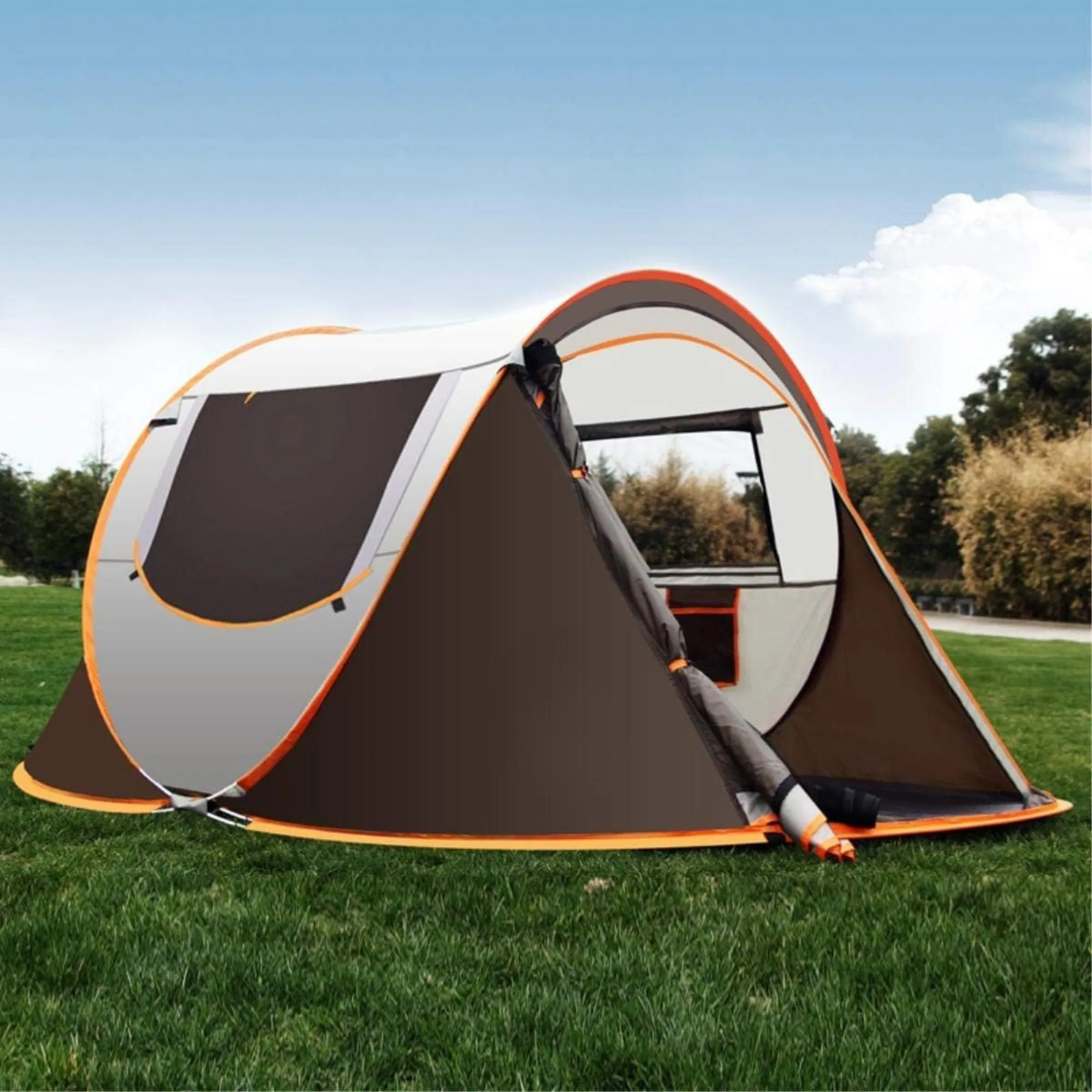
Mastering Door and Window Management
Your tent’s doors and windows are the largest and most adjustable ventilation tools at your disposal. Learning to manage them effectively can dramatically improve moisture control while maintaining comfort.
The “top-down” door technique is particularly effective in winter:
1. Unzip the door from the top down, creating a 3-4 inch (7.5-10 cm) opening at the upper portion
2. This allows warm, moist air to escape while minimizing cold drafts at floor level
3. For double doors, open both slightly rather than one fully for more balanced airflow
For window management in different conditions:
* Above 25°F (-3.9°C): Keep windows partially open on opposite sides
* 10-25°F (-12.2 to -3.9°C): Open top portions of windows while keeping lower sections closed
* Below 10°F (-12.2°C): Open only the highest window points, approximately 1-2 inches (2.5-5 cm)
Popular winter tent models from heavy duty 4-season tent collections often feature specialized window designs with multiple adjustment points specifically for fine-tuning ventilation in extreme conditions.
Snow Skirts and Guy Lines: Often Overlooked Ventilation Tools
Snow skirts (also called snow flaps) serve a dual purpose that many winter campers overlook. While their primary function is to prevent snow from blowing underneath your tent, they can also be strategically adjusted to control ventilation.
During moderate winter conditions, try lifting the snow skirt 2-3 inches (5-7.5 cm) on the protected side of your tent (away from wind) to allow ground-level air exchange without creating drafts. This technique works particularly well for removing the dense, cold air where carbon dioxide collects.
Proper guy line tension also dramatically affects condensation by:
* Creating optimal space between rainfly and tent body (ideally 1-2 inches/2.5-5 cm)
* Preventing rainfly contact with inner tent walls, which creates cold spots
* Allowing moisture to escape through the gap between layers
Adjust your setup based on conditions:
| Weather Condition | Snow Skirt Position | Guy Line Tension |
|---|---|---|
| Cold, clear night | Lift 2-3” on lee side | Maximum tension for airflow |
| Heavy snowfall | Fully deployed | Tighter than normal to shed snow |
| Windy conditions | Fully deployed | Adjust to prevent flapping |
Many experienced winter campers consider proper guy line setup to be as important as vent management for controlling condensation, especially with windproof tents for snow camping where the tight pitch needed for wind resistance must be balanced with ventilation needs.
Vestibule Ventilation: Creating a Moisture Buffer Zone
Tent vestibules serve as valuable transition spaces between the harsh outdoors and your sleeping area. When properly managed, they create a buffer zone that reduces moisture transfer into the main tent body.
Vestibules typically maintain a temperature 10-15°F (5.5-8.3°C) cooler than the main tent interior, making them ideal for moisture management. This temperature differential causes water vapor to condense in the vestibule rather than inside your sleeping area.
To maximize vestibule effectiveness:
* Keep vestibule doors partially open at the top when conditions permit
* Store wet gear in vestibules rather than inside the main tent
* Create a small gap (about 1 inch/2.5 cm) between the ground and vestibule edge for air circulation
* Use vestibules for activities that generate moisture, such as quick snow removal from clothing
Be mindful of vestibule capacity—even large backpacking tent vestibules have limits to how much wet gear they can effectively buffer before becoming moisture sources themselves. As a general rule, keep wet gear at least 4-6 inches (10-15 cm) from vestibule walls to allow proper air circulation.
Minimizing Internal Moisture: Prevention is Key
While ventilation helps remove moisture, preventing excess humidity from entering your tent’s atmosphere is an equally important strategy. Every ounce of water vapor you keep out is moisture you won’t need to ventilate.
Breath management makes a significant difference since each exhale contains substantial moisture. Consider:
* Sleeping with your face outside your sleeping bag when possible
* Positioning your head toward ventilation openings
* Using a breath deflector (even a small towel) during extremely cold conditions
Managing wet gear requires discipline:
* A single wet sock can release approximately 1 oz (30 ml) of moisture
* Heavy gloves can hold 2-4 oz (60-120 ml) of moisture
* Prioritize drying items based on moisture content (boots and gloves first, then outer layers)
Other moisture prevention strategies include:
* Brush off snow before entering the vestibule
* Keep water bottles sealed when inside the tent
* Use vapor barrier liners in sleeping bags for extended trips
* Consider how tent insulation for year-round camping can be optimized for winter moisture control
Heavy Duty 4 Season Tent, Mountaineering Tent, Winter Camping Tent
$870.40 Select options This product has multiple variants. The options may be chosen on the product pageUltralight Backpacking Tent, Ultralight Dome Tent, Winter Camping Tent
Price range: $369.63 through $370.07 Select options This product has multiple variants. The options may be chosen on the product pageHeavy Duty 4 Season Tent, Ultralight Freestanding Tent, Winter Camping Tent
$3,722.66 Select options This product has multiple variants. The options may be chosen on the product pageBackpacking Tent with Vestibule, Freestanding Backpacking Tent, Lightweight Backpacking Tent
Price range: $446.89 through $447.22 Select options This product has multiple variants. The options may be chosen on the product pageBackpacking Tent with Vestibule, Trekking Pole Backpacking Tent, Waterproof Camping Tent
Price range: $271.99 through $519.52 Select options This product has multiple variants. The options may be chosen on the product pageHeavy Duty 4 Season Tent, Winter Camping Tent
$638.69 Select options This product has multiple variants. The options may be chosen on the product page
Safe Cooking Practices to Reduce Moisture
Cooking is one of the largest potential sources of tent moisture, with significant safety implications. Always cook outside your tent whenever possible—not just for moisture control but to eliminate the serious risks of carbon monoxide poisoning and fire.
Boiling just 2 cups (500 ml) of water releases approximately 1 cup (250 ml) of moisture into the air. Multiple hot meals can easily add several cups of unwanted humidity to your tent environment.
If extreme weather forces emergency cooking inside the vestibule (never in the main tent):
* Maximize ventilation completely
* Use a liquid fuel stove rather than canister stoves (they produce less water vapor)
* Keep cooking time to an absolute minimum
* Consider cold-soaking meal options when possible
* Ensure your mountaineering tent has adequate ventilation design if you anticipate emergency cooking needs
Remember that no tent ventilation system can make indoor cooking completely safe from carbon monoxide risks. This invisible, odorless gas causes numerous camping fatalities every year.
Strategic Campsite Selection for Drier Tents
Before you even set up your tent, the location you choose significantly impacts condensation levels. Smart site selection can reduce moisture challenges from the start.
Consider these factors when choosing your winter campsite:
* Elevation microclimate: Higher spots are typically 5-10°F (2.8-5.6°C) drier than valley floors where cold, damp air settles
* Distance from water: Stay at least 200 feet (60 meters) from lakes, streams, or rivers to reduce ambient humidity
* Tree cover: Moderate tree cover creates a microclimate with less temperature fluctuation, reducing condensation
* Snow condition: Fresh, dry snow releases less moisture than older, warming snowpack
* Sun exposure: Eastern exposure provides morning sun to help dry tents
* Ground composition: Avoid camping directly on wet ground when possible
The principles shared in our guide to winter snow tents highlight how seemingly small site selection choices can dramatically impact your overnight comfort by reducing the condensation battle before it begins.
Tent Design Features That Combat Condensation
Tent design plays a crucial role in condensation management, with different designs offering various advantages and challenges in winter conditions.
| Tent Design | Condensation Performance | Best For |
|---|---|---|
| Double-wall | Superior – moisture condenses on fly, not inner tent | Most winter conditions |
| Single-wall | Challenging – requires excellent ventilation | Alpine expeditions where weight is critical |
| Hybrid designs | Good – targeted breathable panels | Mix of conditions |
Double-wall tents with proper spacing (1-2 inches/2.5-5 cm between inner and outer layers) consistently outperform single-wall designs for condensation control. The air gap allows moisture to condense on the rainfly rather than dripping onto occupants.
The tent floor-to-wall seam design significantly impacts performance. Bathtub floors that extend up the sides create better moisture barriers but require additional ventilation considerations. Tents with mesh panels at the transition between floor and wall provide better air circulation but may allow drafts.
Even the best tent performs poorly when improperly pitched. Following the guidelines found in our lightweight tent setup guide ensures optimal spacing between tent components for effective moisture management.
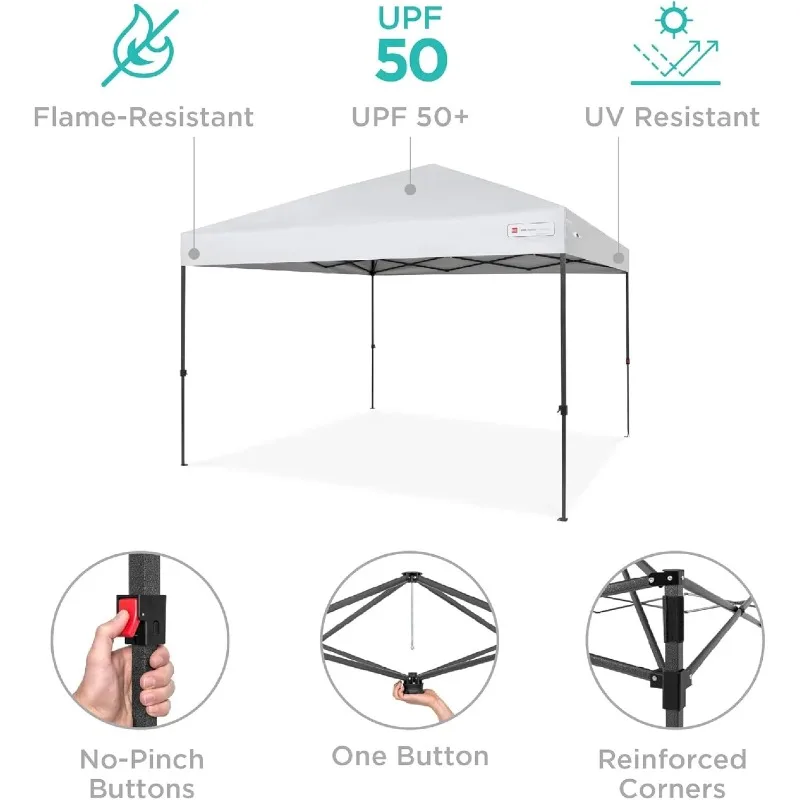
Active Condensation Management Techniques
Despite your best prevention efforts, some condensation is inevitable in winter camping. These active management techniques help address moisture once it forms:
For liquid condensation:
1. Use a small microfiber towel (can absorb 7-8 times its weight in water) to wipe down tent walls in the morning
2. Start at the highest points and work down, wringing the towel outside when needed
3. Pay special attention to corners and seams where condensation collects
For frozen condensation:
1. Never scrape ice from tent walls—this can damage waterproof coatings
2. Allow ice to warm slightly until it loosens naturally
3. Gently brush away loosened ice crystals with a soft-bristled brush
4. If possible, allow afternoon sun to sublimate ice directly to vapor
For extended trips, implement a daily condensation management routine:
* Morning wipe-down of problem areas (10 minutes)
* Mid-day tent airing when weather permits (30-60 minutes)
* Evening pre-emptive drying before temperatures drop
Post-Trip Tent Care for Longevity
Proper post-trip care prevents condensation damage from affecting your tent’s longevity and performance on future adventures:
Completely dry your tent before storage:
* Set up tent in a dry, warm area for at least 24 hours
* Pay special attention to seams, corners, and floor-wall junctions
* Ensure rainfly is completely dry on both sidesClean residue from repeated condensation:
* Use a gentle non-detergent cleaner specifically for technical fabrics
* Focus on areas with visible mineral deposits or discoloration
* Rinse thoroughly without soaking the materialStore properly in a dry, cool location in a loose sack rather than compressed stuff sack
These simple post-trip procedures can extend tent life by years and maintain the fabric’s weather resistance and breathability. For more comprehensive maintenance tips, our canvas tent care guide provides additional relevant information applicable to all tent materials.
Essential Gear for Condensation Management
Having the right tools makes condensation management significantly easier. Consider adding these lightweight items to your winter camping kit:
- Absorbent microfiber towel (2-3 oz/57-85 g): Can absorb 7-8 times its weight in water
- Portable tent fan (3-6 oz/85-170 g): Creates air circulation (battery life: 8-20 hours depending on temperature)
- Hygrometer (1-2 oz/28-57 g): Monitors humidity levels to anticipate condensation issues
- Diffuser sponge (1 oz/28 g): Placed in tent corners to absorb moisture
- Silicone tent brush (2 oz/57 g): Safely removes frost without damaging fabric
These specialized items complement the condensation-fighting features found in compact shelters for two without adding significant weight to your pack. Even adding just the microfiber towel can dramatically improve comfort in challenging conditions.
When to Accept Condensation: Setting Realistic Expectations
Even with perfect technique and equipment, some conditions make condensation unavoidable. Experienced winter campers understand that managing expectations is part of the process.
When temperatures drop below -20°F (-28.9°C), or when camping with multiple people in a small tent, some condensation becomes physically inevitable due to the extreme temperature differential. Each additional person increases moisture production by approximately 30%, creating challenging physics to overcome.
Instead of fighting a losing battle in these situations:
* Focus on keeping condensation away from gear and sleeping areas
* Use vapor barrier techniques inside sleeping bags
* Accept that morning cleanup will be necessary
* Remember that some condensation doesn’t mean your techniques have failed
As seasoned winter campers often say, “Some condensation is just the price of admission for winter camping.” With the right mindset and management techniques, it becomes a minor inconvenience rather than a trip-ruining problem.
Is It Condensation or Leakage? Troubleshooting Guide
Distinguishing between condensation and an actual leak helps you apply the right solution to your moisture problem.
| Characteristic | Condensation | Leakage |
|---|---|---|
| Pattern | Evenly distributed or in specific zones (corners, ceiling) | Concentrated streams or spots |
| Timing | Worst in morning, after temperature drops | Occurs during precipitation |
| Location | Primarily on ceiling and upper walls | Can appear anywhere, often at seams |
| Touch test | Surface feels wet but not soaking | Surface may feel saturated |
| Weather correlation | Occurs even in clear weather | Directly correlates with precipitation |
Simple field test: Wipe the wet area with a dry cloth. If the area remains dry for a few minutes before moisture reappears, it’s likely condensation. If water returns immediately or continues to seep, you’re dealing with a leak.
For leaks, temporary field repairs with seam sealer or repair tape can help manage the situation until proper repairs can be made. For condensation, return to the ventilation and moisture management techniques outlined throughout this guide.
With these comprehensive strategies from Explore Elements, you’ll be well-equipped to maintain a dry, comfortable shelter even in the most challenging winter conditions. While condensation can never be completely eliminated in cold environments, these techniques will minimize its impact on your winter camping experience.

